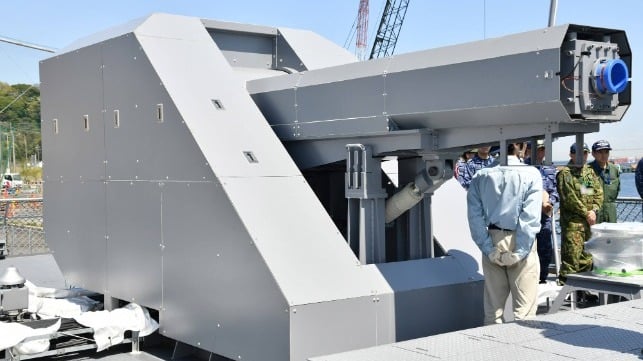Japanese Navy Unveils Electromagnetic Railgun

The Japan Maritime Self Defense Force (JMSDF) has released its first images of a new railgun installed on the service's technology testbed vessel, JS Asuka. The new model appears to be more complete than the previous prototype, which was first displayed in at-sea testing in 2023.
On April 9, Vice Admiral Omachi Katsushi, Commander of the Self Defense Fleet (COMSDFLT), visited JS Asuka for an inspection. The vessel belongs to Japan's Fleet Research and Development Command (FRDC) and the railgun is under development at the Acquisition, Technology & Logistics Agency (ATLA). Naval gun builder Japan Steel Works is closely involved in the project, according to Naval News.
????????????????????????????? ASE-6102?????????????????????????
— ????? (@HNlEHupY4Nr6hRM) April 9, 2025
?????????????????? pic.twitter.com/OuRHhqU4I1
Japan's program has been actively under way since 2016, with testing beginning in 2022. Early work focused on projectile flight stability and the gun's rapid fire performance - a hurdle for railguns, which generate enormous forces in operation and tend to wear out their "barrels."
Previous illustrations of Japan's railgun testing program suggest that at least one projectile could be an antiaircraft fragmentation round, not a solid slug as envisioned by the American R&D program.
??? pic.twitter.com/u5g7A31eEi
— ?????? (@tmy_4ns) April 10, 2025
The U.S. Navy canceled its unclassified railgun work in 2021, citing technical problems; the barrel tended to fail after one to two dozen shots, according to Defense News. It is unknown whether aspects of the $500 million program continued under classified status after cancellation, not uncommon for American defense R&D. Publicly, though, the service has shifted its focus to high-power solid state laser technology for its foray into energy-based weapons. After 10 years of R&D, some U.S. Navy leaders have expressed frustration and regret at the lack of progress with a satisfactory laser platform.
The U.S. Navy reached the 1,000-shot mark with its railgun R&D program in 2012 (Video courtesy USN, 2012)
Energy-driven weapons like lasers and railguns promise a lower-cost, larger-magazine alternative to guided missiles. Future railgun applications include point defense to counter drones, missiles and small craft - an expensive task for missiles, as highlighted by the Red Sea conflict.
Despite their durability issues, railguns have distinct advantages. Unlike line-of-sight lasers, railguns shoot a solid projectile with a cannon-like trajectory, so they can be used to hit targets beyond the curve of the horizon. Railguns are not impeded by low-visibility conditions, which can interfere with laser beams and reduce their effective range; lasers also have a more technically demanding requirement for precision tracking, as they have to focus the beam on the moving target for a longer time period in order to burn through it.
